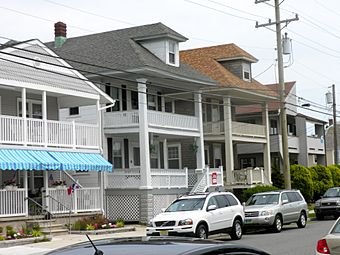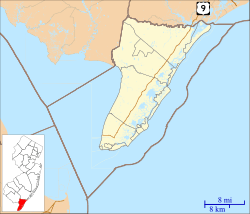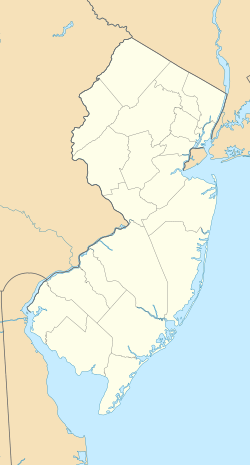Ocean City Residential Historic District facts for kids
|
Ocean City Residential Historic District
|
|

Ocean City Residential Historic District in 2010.
|
|
| Location | Roughly bounded by 3rd and 8th Streets and Central and Ocean Avenues, Ocean City, New Jersey |
|---|---|
| Area | 44.6 acres (18.0 ha) |
| Architectural style | Late Victorian, Late 19th And 20th Century Revivals |
| NRHP reference No. | 03000129 |
Quick facts for kids Significant dates |
|
| Added to NRHP | March 20, 2003 |
The Ocean City Residential Historic District is a special area in Ocean City, New Jersey. It includes 169 old buildings, some built as far back as the 1880s! This district was added to the National Register of Historic Places on March 20, 2003. This means it's recognized as an important place in history.
Contents
History of Ocean City
Before Ocean City became a town, a few families lived on the barrier island called Peck's Beach. In 1879, a group of eight Methodist ministers decided to create a new community. They formed a company called the New Brighton Association.
On October 20, 1879, this group started the Ocean City Association. Their goal was to build a religious resort on the island. They planned the streets in a "grid plan," like a checkerboard. This meant streets ran straight, parallel to each other, and crossed at right angles.
Early Development
On May 25, 1880, the Association began selling land lots. These lots were in the northern part of the island. The main area was a campground between what are now Fifth and Sixth Streets. If people who bought land didn't follow the Association's rules, their property would go back to the Association.
In just one year, 1880, people built 35 houses! They also built a hotel, two bath houses, and ten private stables (places for horses).
Growth and Challenges
Today, 32 houses built in the 1880s are still part of this historic district. One of them was built by Ezra B. Lake, a member of the Ocean City Association. More houses were built in the years that followed. Better transportation, like trains, helped the city grow.
By the 1920s, most of the land in the original northern part of Ocean City was already built on. But the city's growth slowed down a lot in 1929. This was because of the stock market crash and the Great Depression that followed. These events caused a big economic downturn across the country.
Protecting History
In the 1980s, some builders started tearing down older homes. They replaced them with new buildings called duplexes (houses divided into two living spaces). To protect the city's history, Ocean City added a Historic Preservation Plan Element to its main city plan in 1988. This plan helps save important old buildings.
Three years later, in 1991, the city officially named the Ocean City Residential Historic District. It covers the area from Third to Eighth Streets, along Wesley, Ocean, and Central Avenues. The Life-Saving Station at 4th and Atlantic was also included in the district.
Homes in the District
The Ocean City Residential Historic District is home to many interesting houses. Here is a list of some of them, showing their address, when they were built, and their architectural style. Some of these homes are called "contributing properties," which means they help make the district historically important. Others are "not contributing properties," meaning they were built later or changed too much.
| Address | Date | Style | Notes |
|---|---|---|---|
| 300 Central Avenue | ~1950 | Cape Cod revival | Not a contributing property |
| 301 Central Avenue | 1880s | Folk Victorian | |
| 304 Central Avenue | 1890s-1900s | Folk Victorian | |
| 305 Central Avenue | 1880s | Queen Anne | |
| 308 Central Avenue | 1890s-1900s | Folk Victorian | |
| 312 Central Avenue | 1890s | Second Empire | One of the key contributing properties |
| 315 Central Avenue | 1890s-1900s | Folk Victorian | Possibly was moved from another location |
| 317 Central Avenue | 1890s-1900s | Folk Victorian | |
| 321 Central Avenue | ~1918-22 | Colonial Revival | |
| 324 Central Avenue | 1880s | Queen Anne | |
| 325 Central Avenue | 1910s | American Craftsman | |
| 328 Central Avenue | ~1950s | Cape Cod revival | Not a contributing property |
| 329 Central Avenue | 1910s | American Craftsman | |
| 330-332 Central Avenue | 1920s | American Craftsman | |
| 334 Central Avenue | 1892 | Dutch Colonial Revival architecture | One of the key contributing properties |
| 335 Central Avenue | ~1960 | International Style | Not a contributing property |
| 337 Central Avenue | 1930s | Neoclassical revival | |
| 340-342 Central Avenue | 1920s | Colonial Revival | |
| 341 Central Avenue | 1880s | Colonial Revival | |
| 346 Central Avenue | 1880s | Folk Victorian | Car garage added in the 1950s |
| 406 Central Avenue | 1800s | Italianate | |
| 408 Central Avenue | 1890s-1900s | Colonial Revival | |
| 409 Central Avenue | 1920s | American Craftsman | |
| 411 Central Avenue | 1880s | Folk Victorian | One of the original meeting cottages; a key contributing property |
| 412 Central Avenue | ~1910s | Neoclassical revival | |
| 413-415 Central Avenue | ~1910s | American Craftsman/Colonial Revival | |
| 416 Central Avenue | 1890s-1900s | Second Empire | |
| 417 Central Avenue | 1910s | American Craftsman | |
| 420 Central Avenue | 1880s | Queen Anne | |
| 421-423 Central Avenue | 1890s | Second Empire | |
| 425-427 Central Avenue | ~1980s | Contemporary | Not a contributing property |
| 426 Central Avenue | 1890s-1900s | Folk Victorian | |
| 428 Central Avenue | 1880s | Queen Anne | |
| 429-431 Central Avenue | 1890s | Second Empire | |
| 432 Central Avenue | ~1970s-1990s | Contemporary | Not a contributing property |
| 433 Central Avenue | ~1900s | American Craftsman/Colonial Revival | |
| 434 Central Avenue | ~1920s | Colonial Revival | Modified to Second Empire/American Craftsman; not a contributing property |
| 435 Central Avenue | ~1900s | American Craftsman/Colonial Revival | |
| 438 Central Avenue | ~1910 | Folk Victorian | |
| 600 Central Avenue | 1917 | American Craftsman | |
| 601 Central Avenue | ~1990s | Contemporary | Not a contributing property |
| 604 Central Avenue | 1890s-1900s | Second Empire | |
| 608 Central Avenue | 1890s-1900s | Queen Anne | |
| 611 Central Avenue | 1890s-1900s | Folk Victorian | |
| 613 Central Avenue | 1890s-1900s | Folk Victorian | |
| 617 Central Avenue | 1890s-1900s | Second Empire | |
| 618 Central Avenue | 1890s-1900s | Colonial Revival | |
| 622-624 Central Avenue | 1890s-1900s | Queen Anne/Colonial Revival | |
| 623 Central Avenue | 1890s-1900s | Queen Anne | |
| 625 Central Avenue | 1890s-1900s | Queen Anne | |
| 626 Central Avenue | 1890s-1900s | Folk Victorian | |
| 629 Central Avenue | 1880s | Folk Victorian | One of the original meeting cottages; a key contributing property |
| 631 Central Avenue | 1880s | Second Empire | |
| 634-636 Central Avenue | 1880s | Queen Anne | |
| 635 Central Avenue | ~1910 | Neoclassical revival | |
| 638 Central Avenue | 1880s | Folk Victorian | |
| 639 Central Avenue | 1880s | Folk Victorian | |
| 640-642 Central Avenue | 1880s | Queen Anne | |
| 641 Central Avenue | ~1910 | Folk Victorian | |
| 644 Central Avenue | 1880s | Colonial Revival | |
| 650 Central Avenue | 1880s | Folk Victorian | |
| 701 Central Avenue | 1880s | Queen Anne | One of the key contributing properties |
| 705 Central Avenue | 1891 | Folk Victorian | One of the key contributing properties; built for the daughter of Parker Miller, one of the island's first permanent residents |
| 715-717 Central Avenue | 1890s-1900s | Second Empire | |
| 801 Central Avenue | 1890s-1900s | Queen Anne | One of the key contributing properties; the first floor was converted to commercial use |
| 401 Wesley Avenue | 1890s-1900s | Queen Anne | Known as Northwood Inn B&B |
| 403-405 Wesley Avenue | 1880s | Queen Anne | |
| 420 Wesley Avenue | 1880s | Folk Victorian/Gothic Revival | |
| 423 Wesley Avenue | 2001 | Contemporary Queen Anne | Not a contributing property |
| 424 Wesley Avenue | ~1900 | Queen Anne | Known as Dancing Turtle Inn |
| 426 Wesley Avenue | 1800s-1900s | Queen Anne | |
| 428 Wesley Avenue | 1880s | Folk Victorian | |
| 429 Wesley Avenue | 1880s | Queen Anne/Gothic Revival | |
| 435 Wesley Avenue | 1881 | Italianate | One of the key contributing properties; owned by Ezra B. Lake; now known as Scotch Hall Restaurant |
| Reference - National Register of Historic Places Application | |||
Other Important Buildings
The Ocean City Residential Historic District also includes other important buildings. These structures help tell the story of the area.
Ocean City Tabernacle
The district is centered around an open space between 5th and 6th Streets. In 1881, an auditorium was built here. This building became the Ocean City Tabernacle, a place for religious gatherings. The original building was replaced in 1955 by a new one in the same spot.
St. Peter's United Methodist Church
At 8th Street and Central Avenue, you'll find St. Peter's United Methodist Church. It was built in 1908 in a style called Gothic Revival architecture. This style often features pointed arches and tall windows, similar to old European cathedrals.
The church was first a two-story building with a three-story tower. A two-story addition was built in 1956. The church's base is made of strong cast stone and granite. Its outside walls are made of stone and have beautiful stained glass windows. The roof has a special shape called "cross-gabled," with a raised edge (a parapet), tall pointed decorations (called pinnacles), and a bell tower. This church is considered a very important building in the historic district.




